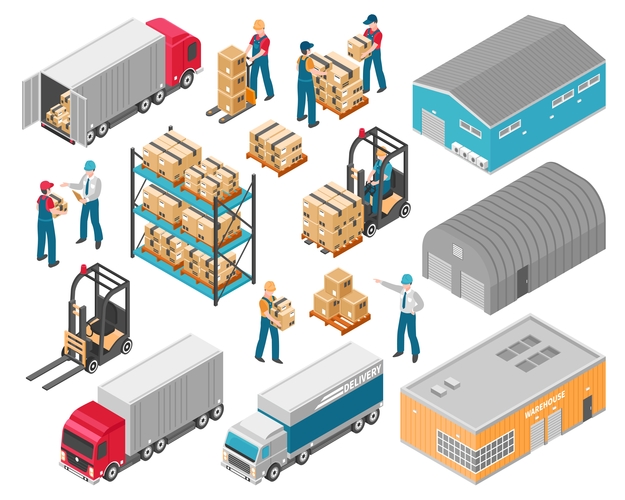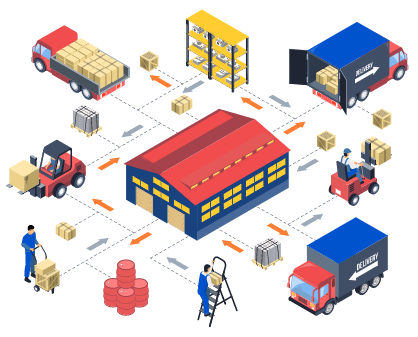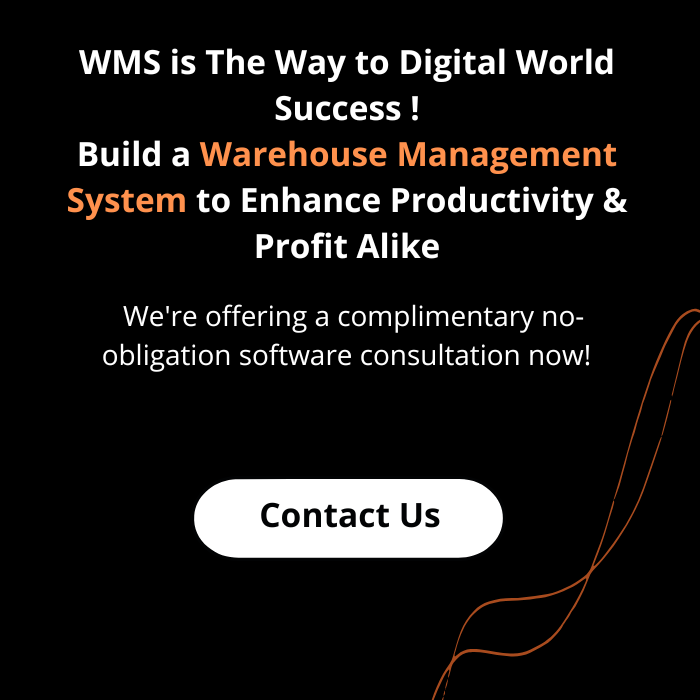Warehouse management system development is no more a ‘industry giants’ thing but an integral part of modern smart businesses. Explore ABCs & more ahead !
“Of course we can offer you what you're looking for! Give us a moment and we’ll grab it out of the warehouse.” followed by “We are extremely sorry sir/ma’am, it seems like we’re out of stock.” within a matter of a few minutes!
Does that sound familiar? Yes, I bet!
You have invariably found yourself in a similar situation at some point of time, either as a customer or a business owner.
Either way, you must be knowing how 'out of stock' updates can disappoint a customer, affecting customer's loyalty and sales.
If you’re making do with an inefficient inventory management process or worse, documenting inventory quantities in pen and paper or maybe using Excel spreadsheets, avoiding human errors can be as difficult as killing Thanos, to say the least!
On the other hand, if you deploy a smart warehouse management system minimizing manual touch points to a great extent, the warehouse operations associated with your ecommerce business will automatically get organized, monitored and speeded up seamlessly.
If you are not quite sure if a warehouse management system really walks the talk, here’s what the numbers have to say! According to a recent study, powered with a warehouse management system you can reap a 25% hike in productivity, a 20% increase in space usage and gain 30% better efficiency in terms of stock usage.
To add to it, 36% of the supply chain experts confidently state that an optimized inventory management system is very central to their analytics initiative for balancing demand and supply.
Get Complimentary WMS Consultation
What is a Warehouse Management System
A warehouse management system often termed as WMS, simply started off functioning the way google map does for a particular region – it showed what’s where in a warehouse and provided an optimized way to pick the desired product. Evolution followed fast and the meaning of a WMS modified accordingly.
Aligned with the contemporary connected consumers’ on-the-go, omnichannel online shopping needs, businesses had to enable instant response in a series of spaces – be it ‘buying’, ‘returning’, ‘exchanging’ or a similar area – thus, enhancing the warehouse management system’s functionality.
Today, a Warehouse Management System refers to a comprehensive software solution that provides a telescopic view of a business’ total inventory and looks after supply chain fulfillment operations starting from the distribution center to the store’s shelf.
Challenges and Solutions of Warehouse Management
Now that the words and numbers have done their job, it’s time to get into the real-life warehouse nitty gritties. Let’s have a look at some of the struggles that manual warehouse management has to deal with and how a dedicated software can resolve those!
[1] Inaccurate warehouse inventory count causing constant worry?
One of the most common problems in manual warehouse management is human error in inventory counts. Be it initial counts, daily inventory counts or errors in regular order picking- all of these errors accumulate over a period of time, finally leading to puzzling gaps in inventory calculations!
Read our blog eBay Chrome Extension to find how you can intergrate your warehouse inventory with your eBay store to ensure real-time updates and eliminate any scope of error!
How about replacing human error with system’s accuracy?
- Implementing a sophisticated warehouse management system which is fed with activity-specific working knowledge, can efficiently collect and process information from each of the interconnected steps associated with the business procedures starting from ‘inventory analysis’ to ‘packing & timely delivery’, and maintains accuracy throughout the completion of the process.
- Tracks down inventory discrepancies at the time of a count and keeps a record of unavailable / misplaced items without delaying the entire process.
[2] The fault in the warehouse design!
The design of a warehouse can either make or break your warehouse operations. While a smart design suiting your unique workflow can add value to your system, a random design can take a toll on the accessibility, leading to increased operational cost and decreased productivity.
Switch to an efficient warehouse architecture!
- A quality warehouse management software can present an efficient warehouse layout allowing fast and easy pick up for the most ordered items while storing the less ordered/ uncommon items at the backside so that they don't unnecessarily block the way for collecting the popular ones.
- Using a warehouse management system also curbs difficulty in picking up the items lying even in the furthest corners of the warehouse with the help of radio frequency and voice directions, by saving both time and efforts.
[3] Unplanned inventory placement invites obstacles galore
Rightly placed inventory can effectively facilitate inventory management as well as smooth execution of overall warehouse operations. Even though at the starting of a business the inventory location seems to cause no apparent problem, over time as newer products are added to the inventory, space availability begins to raise the red flag. Eventually, the space crunch slows down the operations to a considerable extent, giving rise to several corresponding issues in supply and delivery.
Plan your inventory location, don’t let the clutter control your costs!
- Automating the warehouse management system allows organization and even re-organization of inventory placements as and when required, solving the space issue by arranging space for new inventories without harming productivity of the existing inventories.
[4] Order picking operations taking forever to complete?
Picking is a critical activity associated with warehouse management as there are often exceptions in the system- finding an approved substitute for a product, identifying a damaged/ wrong item in an order, to name a few. Such exceptions, if not recorded properly, disrupt the entire record of the inventory. Since there’s a constant push to gratify the customer with on-time delivery, the day-to-day tasks performed and decisions made are often done in a haste, increasing chances of errors.
Upgrade to a quicker picking operation, welcome smart digitization!
- A smart inventory management system auto-records each of the unavailable, damaged, excess or substitute items daily, maximizing transparency in the inventory record. So, you don’t need to waste hours paying scrupulous attention to this mundane chore, trying to normalize a stack of unbalanced inventory sheets at the end of a week or month!
[5] Difficulty in keeping pace with quality control?
In a large number of businesses, there is no distinguished layer dedicated to quality control i.e. workers who supervise quality control are involved in critical business operations like picking orders, packing and shipping. As a result, the errors do not get logged at all.
Go digital to score high on quality quotient!
- A quality control function built within a well-developed warehouse management system accurately records vendor activities, keeps a check on stock rotation and minimizes the requirement of manual processing of items in the warehouse. Thus, with strict quality control enforced, the entire process of warehouse management provides nothing but explicit outcomes.
[6] Having a tough time communicating with logistical chains?
Constant communication with the logistical chain has a direct impact on productivity. However, it’s a real struggle to get the supply chain decision makers on the same page to make strategic decisions regarding various aspects of the warehouse management.
Opt for system-driven communications!
- Keeping in touch with logistical chains becomes easier as the warehouse management software takes over the task of sending and receiving emails along with set follow ups without any need for you to stick to it religiously. To add to it, the software can also help you with factual decision making based out of real-time operational data!
[7] Redundant processes doubling the pre-set timeline?
Repeated execution of the same processes result in a drastic increase in your labor cost. Whether it is a ‘pick ticket’ or ‘cycle count’, all of them need to pass through a number of channels, involving a lot of time as well as resources.
Try a digital solution to kill both birds with one stone!
- Introduction of automation in inventory management compresses the redundant processes to the highest possible extent, e.g. – by replacing the lengthy pick ticketing procedure with a barcode scanning system, both cost and human resource is saved. Not just that, a fitting warehouse management system can bring in digital enhancements to your way of managing purchase orders by bringing all relevant information (e.g. – pick list, UPC & SKU code, location etc.) at your fingertips, at one go, eliminating repetitive cycles.
[8] Product damage affecting warehouse operations?
Maintenance is often looked after as a minor factor in warehouse management, imposing reactive maintenance as the only measure when it comes to damage control. However, this ineffective way of maintenance not only increases the chances of product damage, but also contributes to a significant cash drainage due to lack of prevention.
Keep damage at bay with preventive maintenance!
- A warehouse management system deploys preventive maintenance and so, your inventories are examined periodically, preventing any kind of product damage/ process failure from occurring.
[9] Gratifying customer expectations stressing you?
With each of the e-commerce businesses trying hard to stay ahead of the rest offering striking benefits to the customers, the customers’ expectations have levelled up simultaneously. Be it ‘fast shipping’ or ‘advanced delivery service’, ‘easy returns’ or ‘satisfying customer service’- all of these factors demand equal attention. In such a scenario, ensuring there is no shortage of inventory, avoiding delays in delivery, preventing out-of-stock updates etc. are no more alarming, they are burning problems!
Let the digital enhancements stand up to customers’ expectations!
- While donning multiple hats can be a real task for you, a sensible warehouse management system ensures none slips in between! The software optimizes execution of the chain of tasks starting from ‘managing purchase orders’ to ‘shipping on time’, to ensure the right inventory is present at the right location just at the right time, to live up to customer’s expectations.
[10] Facing trouble handling fluctuations in demand?
Customer demand is highly volatile in nature, as it is influenced by an array of factors- seasons, state of economy at that instant, weather, to name a few. While a sudden global financial crisis can abruptly bring “customer’s purchasing power” down by several notches, festivity contributes to their zeal to shop. Thus, determining stock becomes critical and often causes a heap of products to lie idle in the warehouse due to hasty decisions.
Allow AI-based strategic decisions to do the stock-talk!
- With an advanced warehouse management system strategic decision-making becomes a cakewalk, as it comes straight out of timely and accurate information compared with records from several past years, leading to strong forecasts on consumer’s demand.
Types Of Warehouse Management System
Now that the ‘why’(s) for a Warehouse Management System is sorted, it’s time to dig into the ‘which’ i.e. which WMS would do the best justice to your warehousing needs?
Because, like dietary needs vary from one person to another and a teenage athlete following the same diet as a teenager having no physical activity can have irreparable physical damage, squeezing your business needs into a WMS that’s a misfit will only cripple the system. Period.
Saving you from the trouble, here’s a list of the most popular types of WMS and how to choose the right one:
[1] Standalone systems
Budget-wise standalone warehouse management system software is the most affordable of the lot, and given that, it obviously is the most basic one – off all the advanced features tailored to perform specifically your business’ warehousing requirements.
What does Standalone systems do?
Standalone warehouse management systems are the most common ones making rounds in the market, containing only the primary features of a WMS software including but not exceeding much beyond:
[i] Tracking Date of Expiration
[ii] Scanning Barcode
[iii] Counting Cycles
[iv] Slotting
[v] Putting away
[vi] Receiving Inventory Stock Details
[vii] Picking
[viii]Packing
[ix] Shipping
What are the drawbacks?
Being available as a standalone package, these warehouse management systems are deployed on-premises and then integrated with an existing software to work along the flow. Integrating a foreign program with your ongoing system sure ‘works’ but not as smoothly (or any close to so!) as you would have pictured it to. Moreover, problems like redundant data entry, information silos, delayed updates, interface issues are imperative if the system is not developed aligned with business-specific needs & workflow, thus leading to added expenses every now and then for more tools & customization in order to deal with unforeseen interruptions in the WMS functioning.
Standalone systems is suitable for..
Standalone systems make for a good solution when it comes to the small businesses that run on very simple logics and can’t afford the budget for a sophisticated WMS.
[2] Cloud-based systems
Cloud-based warehouse management systems are available as a web-based SaaS (software-as-a-service) model. Because of the enterprise cloud technology, it enables the traditional WMS benefits for a lesser cost in spite of a faster implementation.
What does Cloud-based systems do?
Being web-based, these WMS don’t require complex installation or any on-premises integration. Customizations in these are easy and cost-effective & so is its multi-location Third Party Logistics (3PL) management functionality. This complexity, operational size and volume agnostic cloud-based software is built to seamlessly adapt to business’s particular requirements and catalyse productivity and thus, growth – all without altering the long-practised existing business flow.
Cloud-based systems is suitable for..
With quick deployment, easy scalability, high security, improved disaster management, reduced infrastructure maintenance and more of such advantages, the cloud-based WMS are an effective solution for the companies having the hunger for the competitive edge by tapping into the strikingly efficient modern WMS features.
[3] Supply chain modules
Supply Chain Management (SCM) software is actually the parent category for WMS, implying its scope is much broader than warehouse management systems. The supply chain module single-handedly manages out-and-out supply chain operations.
What does Supply chain module do?
The primary functions of an SCM include automation of inventory management, product cycles, material sourcing etc. Additionally, it can also be built to perform risk assessment, synchronising ongoing business processes, maintaining relations with external vendors and more.
To use an SCM as a warehouse management system, your business needs to –
[i] Invest in supply chain applications having in-built warehousing features
Or,
[ii] Develop a custom SCM that doubles as a WMS – both ways designed to cater to specific business needs
Opting for the second, your warehouse can explore the best of both world instead of some from both.
Supply chain module is suitable for..
Those who already have dedicated warehouse and inventory management software in place and are thinking of having an SCM solution onboard. To minimize overlaps with the existing software in use, the wise thing to do is –
[i] Combine the existing software into a holistic SCM platform
Or,
[ii] Choose an SCM ( think custom!! ) that can efficiently integrate with the existing software without causing frequent (or any!) interruption
[4] ERP modules
Enterprise Resource Planning (ERP) software, which is a software for managing the resource base of an enterprise, typically binds in the automated features of the major organizational spheres like HR, sales and marketing, finances and CRM. But wait, weren’t we talking about WMS..are we derailed off the discussion? Nope! Read why.
What does ERP modules do?
ERP modules, if tailored to fit your business requirements, can improve the ROI, and sharpen the competitive edge, takinging over WMS functionalities.
Deserving to be the core component of any business having to do (little or a lot, or anything in between) with supply chain, ERP can perform warehouse management work, besides doing its usual tasks.
ERP modules is suitable For..
for organizations looking for a wholesome centralized solution to take care of various organizational aspects including inventory matters and supply chain needs at one go, an advanced ERP module embedded with a power packed WMS or SCM module is THE solution .
P.S – we also recommend you to check out our blog on facility management software and the benefits they can impart to your business!
Off The Shelf (OTS) Vs. Custom Warehouse management System
Now that you know how a solid inventory management system is capable of uplifting your business growth, you must have already started planning (or maybe, even opened a few tabs already!) to get an efficient inventory management software for your business? Hold on a minute! Before you settle for just any warehouse management system, it’s important to verify if it’s the right tool to serve your intended purpose. The question here is, should you opt for an off-the-shelf (OTS) software making rounds in the market, or do you need to invest in a custom warehouse management software?
Let’s figure out which software can benefit you the most!
[1] Do you want scalability in your warehouse management system?
An OTS software is designed to cater to several businesses requiring digital help with warehousing and thus, prioritises a common need. For example, if your specific warehouse demands to scale up order dispatch activity to fulfill a new mega-deal, hard luck with that!
Whereas, a custom software is built to serve your core business goal and hence, it can easily scale any particular segment of your software.
[2] Want your software to adapt to industrial trends influencing your business only?
OTS will disappoint you then. Because an OTS software puts the needs of the majority of businesses using that software at the frontiers. So, generally an OTS software would not deploy a particular business trend unless there is a common demand from its community of users. However, a custom software implements the trend that solely interests you and doesn’t depend on what impacts other businesses.
[3] Do you mind having junk features in your software which some other business requires?
Probably not! But an OTS being a ready-made software, consists of a fixed set of features, which means, there are quite a few excess features which your business might never need, yet, has to encounter in your day-to-day activities. On the other hand, a custom software is your no-fuss solution, where you tick the features that’s essential for your business process. Want a smart barcode scanning system? Check! Don’t require multi location management since you want the warehouses to operate single-handedly? Uncheck! It’s that simple.
Read More : Ecommerce Features – All Check Or Pass, Clarified!
[4] Would you like to fit your workforce in some other’s workflow?
Because, that’s what an OTS will offer you since it deploys a generic workflow to serve the entire community of users! Suppose your business is established entirely online and your workflow has nothing to do with omni-channel shipment. But, omnichannel shipment being a common part of other’s workflow, would be implemented regardless of how compatible your workflow is with that feature.
But if you want to fit your human capital in your very own unique long-practised workflow rather than someone else’s, then a custom warehouse management software will be your go-to solution, providing you a reasonable set of features to satisfy your custom business needs only..
[5] Would you compromise quality for cost?
Apparently, custom software development demands more time and higher cost compared to OTS, as it comes off as a compact software containing every feature as per your requirement. However, after using an OTS for some months or even a few weeks, requirements of additional features come up eventually. To get the work done, the OTS then needs to undergo sudden modifications causing interruption in ongoing business processes without any notice, adding to significant delay. Also, the OTS mostly has no provision for modification unless the feature you want to incorporate serves its entire community of users. Hence, you need to purchase and run multiple softwares simultaneously, crossing your budget and draining your time.
For example, what if you want your inventory management software to generate sales reports in several forms like sales per product and its type, per product and customer/ customer group, product units in your warehouse and its current stock value etc. along with a sales summary, and the OTS offers you only one or two of such reports. Would you settle for such half-hearted reports because of the OTS charging you less, or invest a few bucks more in custom development to get a holistic solution instead? Choice is yours!
[6] Are you willing to waste time teaching your workmen to use a technology they don’t have an idea about?
Asking, because an OTS will require you to do so! Being built using a generic tech stack suggested by the majority of its users, OTS makes your employees learn what’s convenient for the rest, without considering the solution which will be easier for your workforce to get started with.
On the contrary to that, a custom warehouse management system, the developing company sits with your employees to discuss what technology they are used to, in order to implement functionalities entirely aligned with their convenience.
Last but not the least,
[7] Would you mind letting go of your USP?
Since an OTS software is sold to several businesses, it doesn't take into account a technique or business method specific to your business. Thus, you need to give up that ‘secret sauce’ technique as you opt for an OTS! .
In case that doesn’t sound like a great idea, you have an alternate here- a custom developed warehouse management system! Since a custom software is built with your custom workflow as its backbone, you can keep your USP instact, without missing out on your competitive advantage.
You may also read: 5 symptoms your business needs custom software development
That’s about it!
Warehouse management system is that necessary evil you have been in search for so long, to manage your complex warehouse operations. Every business excelling in the warehouse management is aware of that already and voila! now you know about it, too!
Now that you have a 360 degree idea of the potential of a custom warehouse management software application over an OTS solution, it’s time to get your desired features listed as the first step towards welcoming the game changer in business!



.png)


.png)

.jpg)





.png)